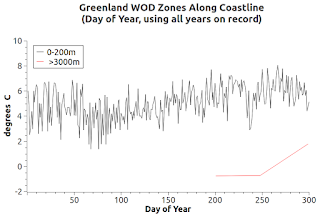 |
| Fig. 1 Layer Nine |
Today, I am fixing the bug that stops the day-of-year at 300 instead of at 366 (see graphs, including yesterday's).
Future day-of-year graphs will have all 366 days (where there is data on those days of course).
I haven't spotted any other bugs.
Anyway, these beta graphs still tell us a lot about subsurface dynamics.
For a quick example, compare Fig. 1 with Fig. 2.
Notice the difference in temperature dynamics between Layer Nine (equatorial), in Fig. 1, and Greenland (Arctic area) coastal water temperatures in Fig. 2.
(The "Layers" concept was presented in the series: The Layered Approach To Big Water, 2, 3, 4, 5, 6).
 |
| Fig. 2 |
The Greenland lines blend and cross over so radically that I added graphs that have only two levels per graph (Fig. 3a - Fig. 3f).
Even with that limitation, the arctic area lines still blend more than the equatorial zone temperature lines do.
I plan to do these again sometime in the future, after splicing in the OMG dataset as it grows (OMG: Oceans Melting Greenland).
Getting back to today's graphs, I also added "Salinity" graphs in the same day-of-year format (Fig. 4a - Fig. 4g).
The Greenland water salinity values are more stable than the water temperature values are, except for the upper level (0-200m).
Notice the large drop in salinity at that upper level on about day 240 of each year (probably caused by a lot of fresh water flowing from the ice sheet).
Gotta get back to work now.
The previous post in this series is here.
 |
| Fig. 3a |
 |
| Fig. 3b |
 |
| Fig. 3c |
 |
| Fig. 3d |
 |
| Fig. 3e |
 |
| Fig. 3f |
 |
| Fig. 4a Salinity |
 |
| Fig. 4b Salinity |
 |
| Fig. 4c Salinity |
 |
| Fig. 4d Salinity |
 |
| Fig. 4e Salinity |
 |
| Fig. 4f Salinity |
 |
| Fig. 4g Salinity |



